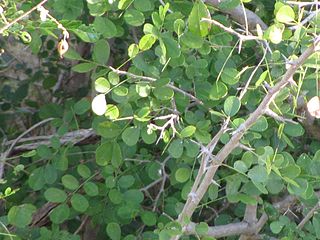
Dalbergia melanoxylon is a flowering plant in the family Fabaceae, native to seasonally dry regions of Africa from Senegal east to Eritrea and south to the north-eastern parts of South Africa. The tree is an important timber species in its native areas; it is used in the manufacture of musical instruments and fine furniture. Populations and genomic resources for genetic biodiversity maintenance in parts of its native range are threatened by overharvesting due to poor or absent conservation planning and by the species' low germination rates.

Pterocarpus santalinus, with the common names red sanders, red saunders, Yerra Chandanam, Chenchandanam, red sandalwood, Rakta Chandana, and saunderswood, is a species of Pterocarpus endemic to the southern Eastern Ghats mountain range of South India. This tree is valued for the rich red colour of its wood. The wood is traditionally considered not aromatic. However, in recent years there has been a marked uptick in the use of red sandalwood as a component of incense, especially in the west. The tree is not to be confused with the aromatic Santalum sandalwood trees that grow natively in Southern India.
Dalbergia baronii is a species of flowering plant in the legume family Fabaceae. It is endemic to Madagascar. It is named after the English missionary and botanist Rev. Richard Baron.
Dalbergia bathiei is a species of legume in the family Fabaceae. It is found only in Madagascar. It is threatened by habitat loss.
Dalbergia bojeri is a species of legume in the family Fabaceae. It is found only in Madagascar. It is threatened by habitat loss.
Dalbergia brachystachya is a species of legume in the family Fabaceae. It is found only in Madagascar. It is threatened by habitat loss.
Dalbergia capuronii is a species of legume in the family Fabaceae.
Dalbergia delphinensis is a species of legume in the family Fabaceae. It is found only in Madagascar. It is threatened by habitat loss.
Dalbergia hirticalyx is a species of legume in the family Fabaceae. It is found only in Madagascar. It is threatened by habitat loss.
Dalbergia louvelii is a species of legume in the family Fabaceae. It is found only in Madagascar. It is threatened by habitat loss.
Dalbergia maritima is a species of legume in the family Fabaceae; it is a rosewood, and its wood is often referred to as Bois de Rose. It is found only in Madagascar. It is threatened by habitat loss due to the over-consumption of its species.
Dalbergia normandii is a species of legume in the family Fabaceae. It is found only in Madagascar. It is threatened by habitat loss.
Dalbergia oliveri is a species of legume in the family Fabaceae which grows in tree form to 15 – 30 meters in height. The fruit is a green pod containing one to two seeds which turn brown to black when ripe. It is threatened by habitat loss and over-harvesting for its valuable red "rosewood" timber.
Dalbergia orientalis is a species of legume in the family Fabaceae. It is found only in Madagascar.
Dalbergia pseudobaronii is a species of flowering plant in the legume family Fabaceae. It is endemic to Madagascar. Its leaves are similar to those of Dalbergia baronii, which gave the species its name.
Dalbergia tsaratananensis is a species of legume in the family Fabaceae. It is found only in Madagascar. It is threatened by habitat loss.
Dalbergia urschii is a species of legume in the family Fabaceae. It is found only in Madagascar.

Ambohitantely Special Reserve is a 5,600-hectare (14,000-acre) wildlife reserve of Madagascar.

Gilbertiodendron dewevrei is a species of tree in the family Fabaceae, native to tropical rain forests in Central Africa. It is often the dominant tree species of the Guineo-Congolian rainforest. The timber is traded as limbali, and is used for construction, flooring and railway sleepers. It is also used for making boats, furniture, tool handles and joinery and for making charcoal.
Dalbergia occulta is a species of flowering plant in the legume family Fabaceae. It is endemic to Madagascar. Its original description was based on a single collection, which explains its botanical name.




